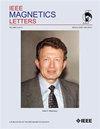Magnetic Field Enhancement of Water Evaporation in Confined Spaces
IF 1.1
4区 物理与天体物理
Q4 ENGINEERING, ELECTRICAL & ELECTRONIC
引用次数: 0
Abstract
Water is studied in confined environments where it evaporates into its own vapor. Simultaneous experiments are conducted for 0.4–0.5 µL droplets confined at the center of 54 mm long microchannels with a cross section of 0.38 mm 2 in the presence and absence of a 300 mT magnetic field. Results are compared with those for water in half-filled 100 mL beakers. The magnetic enhancement of the evaporation rate is much greater in the microchannels, where effects range up to 140% even though the air is saturated with water vapor, as compared to 12 ± 7% in a 500 mT field in the beakers. The average steady state, no-field evaporation rate of 0.13 kg密闭空间中水蒸发的磁场增强
水是在密闭的环境中被研究的,在那里它会蒸发成自己的蒸汽。在存在和不存在300 mT磁场的情况下,对限制在横截面为0.38 mm2的54 mm长微通道中心的0.4–0.5µL液滴进行了同时实验。将结果与半填充的100 mL烧杯中的水的结果进行比较。在微通道中,蒸发率的磁增强要大得多,即使空气中充满了水蒸气,其影响范围也高达140%,而在烧杯中,在500 mT的磁场中,其影响为12±7%。微通道中0.13 kg$\cdot$m−2$\cdot$h−1的平均稳态无场蒸发率大约是烧杯中的两倍,但低于静止空气中开放表面的预期值。磁增强是根据水蒸气的邻核和对位核异构体来分析的,它们表现为独立的气体。新鲜蒸汽中的邻位∶对位比接近2:3,与环境空气中3:1的平衡比大不相同。所施加磁场的梯度增加了蒸发,这使水分子中氢的两个质子自旋的拉莫尔进动去相位,并趋于平衡蒸汽中的异构体布居,从而增加了蒸发率。
本文章由计算机程序翻译,如有差异,请以英文原文为准。
求助全文
约1分钟内获得全文
求助全文
来源期刊

IEEE Magnetics Letters
PHYSICS, APPLIED-
CiteScore
2.40
自引率
0.00%
发文量
37
期刊介绍:
IEEE Magnetics Letters is a peer-reviewed, archival journal covering the physics and engineering of magnetism, magnetic materials, applied magnetics, design and application of magnetic devices, bio-magnetics, magneto-electronics, and spin electronics. IEEE Magnetics Letters publishes short, scholarly articles of substantial current interest.
IEEE Magnetics Letters is a hybrid Open Access (OA) journal. For a fee, authors have the option making their articles freely available to all, including non-subscribers. OA articles are identified as Open Access.
 求助内容:
求助内容: 应助结果提醒方式:
应助结果提醒方式:


